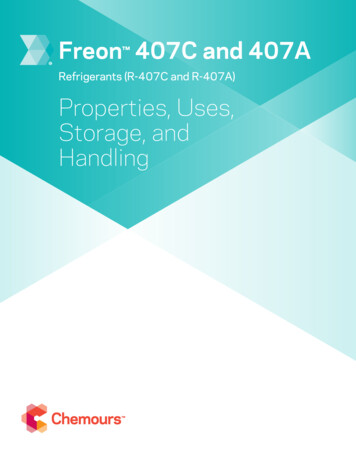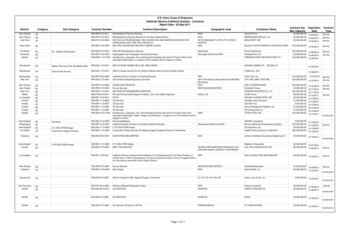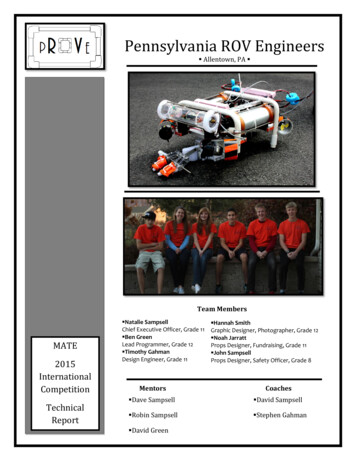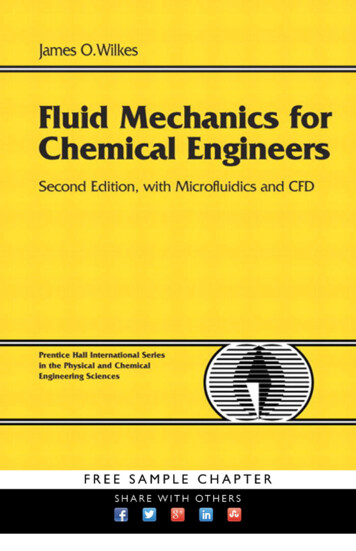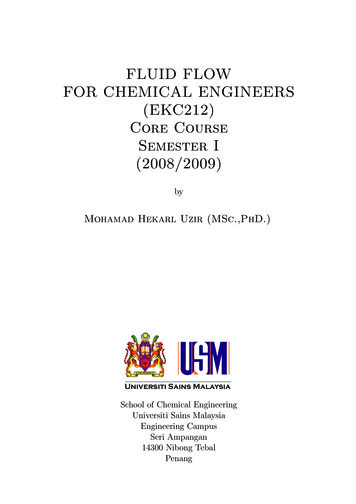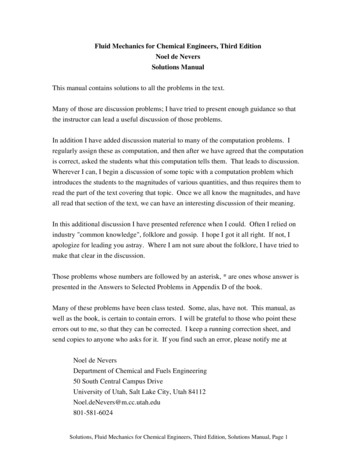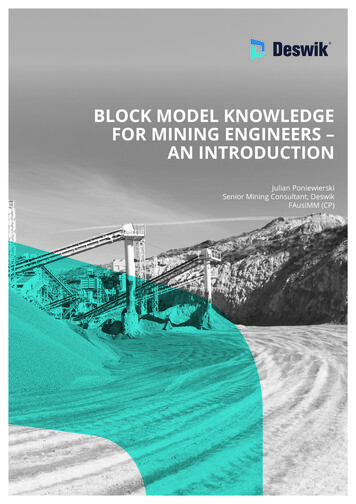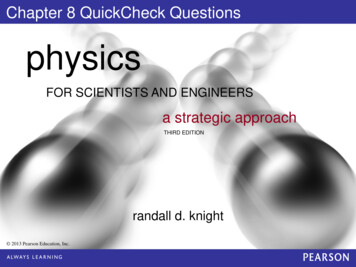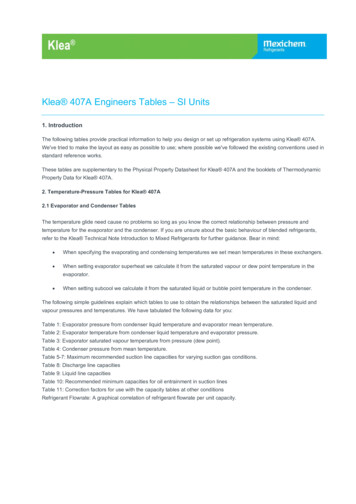
Transcription
Klea 407A Engineers Tables – SI Units1. IntroductionThe following tables provide practical information to help you design or set up refrigeration systems using Klea 407A.We've tried to make the layout as easy as possible to use; where possible we've followed the existing conventions used instandard reference works.These tables are supplementary to the Physical Property Datasheet for Klea 407A and the booklets of ThermodynamicProperty Data for Klea 407A.2. Temperature-Pressure Tables for Klea 407A2.1 Evaporator and Condenser TablesThe temperature glide need cause no problems so long as you know the correct relationship between pressure andtemperature for the evaporator and the condenser. If you are unsure about the basic behaviour of blended refrigerants,refer to the Klea Technical Note Introduction to Mixed Refrigerants for further guidance. Bear in mind: When specifying the evaporating and condensing temperatures we set mean temperatures in these exchangers. When setting evaporator superheat we calculate it from the saturated vapour or dew point temperature in theevaporator. When setting subcool we calculate it from the saturated liquid or bubble point temperature in the condenser.The following simple guidelines explain which tables to use to obtain the relationships between the saturated liquid andvapour pressures and temperatures. We have tabulated the following data for you:Table 1: Evaporator pressure from condenser liquid temperature and evaporator mean temperature.Table 2: Evaporator temperature from condenser liquid temperature and evaporator pressure.Table 3: Evaporator saturated vapour temperature from pressure (dew point).Table 4: Condenser pressure from mean temperature.Table 5-7: Maximum recommended suction line capacities for varying suction gas conditions.Table 8: Discharge line capacitiesTable 9: Liquid line capacitiesTable 10: Recommended minimum capacities for oil entrainment in suction linesTable 11: Correction factors for use with the capacity tables at other conditionsRefrigerant Flowrate: A graphical correlation of refrigerant flowrate per unit capacity.
2.2 Using the Tables In setting up a system to give a specified mean evaporating temperature, you simply look up the pressure youneed in the evaporator using the temperature of liquid at the expansion valve and the mean temperature you wantin Table I. The liquid temperature at the valve has only a slight effect on the mean temperature but we have tabulated itnonetheless. For practical purposes the evaporator pressure will not vary significantly even if the liquidtemperature at the valve changes. To set the mean temperature for the condenser just look up the mean condensing pressure in Table 2. To calculate the superheat for a given pressure, use the table of saturated vapour temperatures (dew points) togive you the saturation temperature for the vapour leaving the evaporator. To calculate the subcooling for a given pressure, use the table of saturated liquid temperature (bubble point) as afunction of pressure. You can also readily estimate the mean temperatures from pressure readings using these tables. The capacity tables follow the standard layouts used in other reference sources.2.3 Worked examples for mean pressure/ temperature tables:(i) Setting the evaporator pressureProblem:Liquid temperature at valve: 40 C.Desired evaporating temperature: -25 C.What is the evaporator pressure to use?What is the effect of a liquid temperature of 30 C?Solution:For Klea 407A, with a liquid temperature at the valve of 40 C and a desired mean evaporating temperature of -25 C,read Table I to get an evaporator pressure of 2.07 bara. A liquid temperature of 30 C gives an evaporator pressure of 2.09bara.a change of I %.(ii) Finding the evaporator temperature from a gauge reading:Problem:Evaporator pressure gauge reads 2.5 bara.Measured exit temperature (from thermometer) is -15.5 C.
What is the mean evaporator temperature?What is the superheat in the evaporator?Solution:For Klea 407A, we have a measured evaporator pressure of 2.5 bara and a measured exit temperature of -15.5 C; wewant to check superheat and evaporating temperature. The liquid temperature is 40 C. Table 2 shows that the meanevaporating temperature is -20.4 C. The superheat is calculated from the dewpoint, given in Table 3 as -18.7 C; hence wehave a working superheat of 3.2 C, obtained by subtracting the dew point temperature from the measured exittemperature.(iii) Setting up the condenser pressure and subcool:Problem:Target mean condenser temperature is 40 C. The liquid temperature at the valve will be 30 C. What is the condensingpressure? What degree of subcooling will be required?Solution:Table 3 supplies the condenser pressure of 17.5 bara for a mean condenser of 40 C. Then the subcooling is obtained bysubtracting the liquid temperature of 30 C from the bubble point of 37.8 C, giving a subcool of 7.8 C.3. Refrigerant Line Capacity Tables3.1 Methods used to generate the tablesThe tables presented here have been developed using the methodology described in the ASHRAE Handbook:Refrigeration Systems and Applications (1994). The physical property data used to generate these tables are correlated inthe Klea datasheets and thermodynamic tables. Pressure drop has been estimated using the Colebrook equation toobtain friction factors and the Darcy-Weisbach equation for pressure drop.Gas Compressibility EffectsIn calculating the maximum capacity (flowrate) it has been assumed that the gas is incompressible. This is in line with thetables published in the ASHRAE Handbook and for most systems this is perfectly adequate.The assumption of incompressibility may however over-predict capacity if the total pressure drop is appreciable comparedto the static pressure. The likely over-prediction will be in the region of 5-10% depending on the evaporator pressure andtotal line loss (including fittings loss).Mexichem recommends that the pressure drop obtained for a line using these tables should be compared to the totalpressure available; if it is greater than 5% of the static pressure then the compressibility may have some effect, and sizingshould be made on that basis.
3.2 Suction Line Capacity TablesThese tables give capacities for cycles operating under the following conditions:Condenser mean temperature 40 C. Zero subcooling (i.e. liquid at bubble point) Vapour leaving evaporator (i) saturatedi.e. at dew point or (ii) superheated (superheat quoted in the table) Evaporator temperatures quoted are true mean values.The capacity for other liquid temperatures may be found using the tabulated correction factors given in Table 11. Note thatthe tables are referenced to a mean condenser of 40 C; the liquid temperature (bubble point) corresponding to thiscondition is quoted in the tables.The tables quote capacity for pressure drops in the mean evaporating pressure equivalent to a drop in saturationtemperature of 0.01, 0.02 and 0.04 Kelvin for every metre of suction line. Data are presented for copper tubing, Type L,and Schedule 40 steel pipe with dimensions as given in the ASHRAE Handbook HVAC Systems and Equipment (1992).The mass flowrate of refrigerant is also presented graphically as the flow in kg/hr required for a duty of I kW refrigerationover a range of evaporating temperatures and liquid temperatures.3.3 Discharge Line Capacity TablesThese have been calculated on the following basis: Condenser mean temperature of 40 C. Zero subcooling i.e. liquid atbubble point. Vapour leaves evaporator at dew point i.e. zero useful superheat. Superheat at compressor discharge is (i)45 or (ii) 60 C. Evaporator temperatures are true mean values.3.4 Liquid Line Capacity TablesThese are quoted for conditions of (i) 0.5 m/s maximum velocity or (ii) 0.02 K/m drop in saturation temperature. Use thevelocity criterion for sizing self-venting lines.3.5 Correcting for other Temperature Drops or Line LengthsThe suction capacity tables reference according to saturation temperature losses of 0.01, 0.02 and 0.04 K in one metrelength. In order to correct the capacities for different values of temperature drop or line length, use the following equation:Capacity Table Capacity x (Required Te x Table Le) 0.54Table Te Required Lewhere: Te is the change in evaporating temperature Le is the length of suction lineTo evaluate the change in saturation temperature for differing capacities or line lengths, use the equation :Actual Te Table Te X (Actual Le) x [Actual Capacity] 1.8Table CapacityTable Le
4. What's New In This EditionThis is version 1.1 of the Tables. The updates from version 1.0 are as follows:Tables 5-9: A revision of the physical property routines and calculation methods has occurred so that all physicalproperties used in the calculation are now obtained from the most recent physical property datasheets for each refrigerant.Tables 5-9: The nomenclature in the tables has been changed slightly to make it more readable.Tables 5-11: The number of significant figures in the tables is revised to three to better reflect the accuracy limits of thecalculations.Tables 10: The oil-refrigerant calculations have been carried out using new data for the solubility of Klea 407A inUniqema’s EMKARATE RL32S and RL68S lubricants.Table 11: The changes in physical property calculations have resulted in some changes to the correction factors displayedin this table.
Table 1: Evaporator pressure from liquid temperature and mean evaporating temperature Klea 407A Pressure in baraTemperaturemean ature liquid 61.591.52Temperaturemean 71.50-33-34-35-36-37-38-39-40Temperature liquid .03
Table 2: Mean evaporator temperature from pressure and liquid temperature Klea 44.14.24.34.44.54.64.74.8Temperature liquid 5Note: Superheat should be set from dew pointTempDew 07-6.38-5.69-5.02-4.36-3.71-3.08-2.45-1.84-1.23
.18.28.38.48.58.68.78.8Temperature liquid 15.47Note: Superheat should be set from dew pointTempDew 617.54
rature liquid 18.3718.7219.0719.4119.75Note: Superheat should be set from dew pointTempDew .4620.8121.1621.5021.85
Table 3: Condenser mean pressure, dew and bubble points, from the mean temperatureKlea 407AMean temp CPressure 3Bubble/liquidTemp .30Dew temp 161.68
Table 4: Condenser bubble, dew and mean temperatures from condenser pressureKlea 407APressure 12.612.81313.213.413.613.81414.214.414.614.81515.2
Table 1: Evaporator pressure from liquid temperature and mean evaporating temperature - Klea 407A Pressure in bara Temperature mean C Temperature liquid C Temperature mean C Temperature liquid C 30 40 50 30 40 50 5 6.37 6.33 6.27 -33 1.47 1.45 1.43 4 6.17 6.12 6.07 -34 1.40 1.39 1.37
